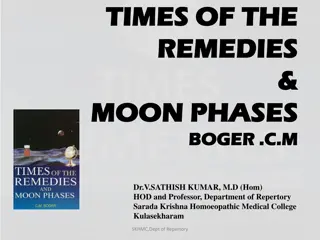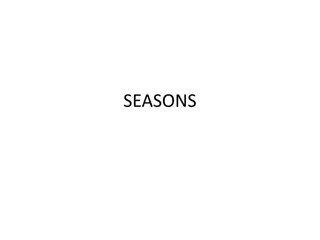Understanding the Phases of the Moon
The Moon's phases, including New Moon, Waxing Crescent, First Quarter, Full Moon, Waning Gibbous, Last Quarter, and more, are due to its revolution around the Earth. Each phase is unique, from the dark New Moon to the brilliant Full Moon, offering insights into celestial mechanics and lunar visibility.
Download Presentation

Please find below an Image/Link to download the presentation.
The content on the website is provided AS IS for your information and personal use only. It may not be sold, licensed, or shared on other websites without obtaining consent from the author. Download presentation by click this link. If you encounter any issues during the download, it is possible that the publisher has removed the file from their server.
E N D
Presentation Transcript
As the Moon Changes NSF North Mississippi GK-8
Why does the moon have phases? The revolution of the Moon around the Earth causes the Moon to appear to have phases. NSF North Mississippi GK-8
8 Phases of the Moon New Moon Full Moon Waxing Crescent Waning Gibbous First Quarter or Half Moon Last Quarter or Half Moon Waxing Gibbous Waning Crescent NSF North Mississippi GK-8
New Moon The moon is not visible from Earth. The moon is between the Sun and the Earth. The dark side is facing us. This phase lasts one night. NSF North Mississippi GK-8
Waxing Crescent Waxing means that the bright side is increasing. The right side is the bright side. Less than one half of the moon is illuminated. This phase includes any visible moon from a small sliver to almost half. NSF North Mississippi GK-8
First Quarter or Half Moon The entire right side of the moon is illuminated. The moon looks like a half circle. The illuminated side is increasing. This phase only lasts one night. NSF North Mississippi GK-8
Waxing Gibbous Gibbous means that more than one half is visible, but it is not quite full. This phase includes the night after the first quarter to the night before the full moon. NSF North Mississippi GK-8
Full Moon The moon is full and bright. It looks like a large circle. The illuminated side is facing us. Only happens one night per lunation. NSF North Mississippi GK-8
Waning Gibbous The moon appears more than half but not quite full. Waning means that the illuminated side is decreasing. The left side is the bright side. NSF North Mississippi GK-8
Last Quarter or Half Moon Left Half of the moon is illuminated. The illuminated side is decreasing. This phase also only lasts for one night. NSF North Mississippi GK-8
Waning Crescent Less than one half of the moon is illuminated. The moon will continue to become smaller and smaller. NSF North Mississippi GK-8
Sources Col, Jeananda. Enchanted Learning. Zoom Moon. Accessed 2005 July 27. <http://www.enchantedlearning.com/subjects/astrono my/moon /Phases.shtml>. Cooley, Keith. 2001. Moon Phases. Accessed 2005 July 27. <http://home.hiwaay.net/~krcool/Astro/moon/moonp hase/>. U.S. Naval Observatory. 2003 September. Astronomical Applications Accessed 2005 July 27. <http://aa.usno.navy.mil/faq/docs/moon_phases.html>.























